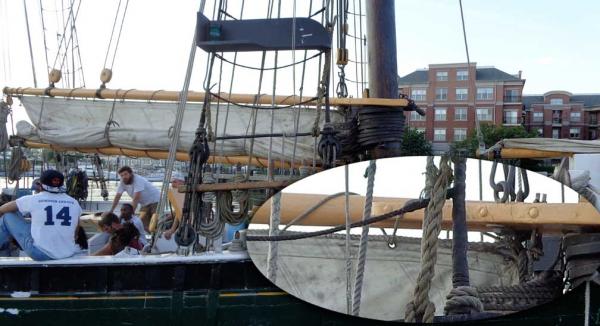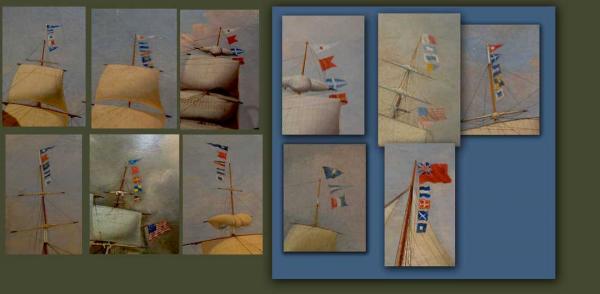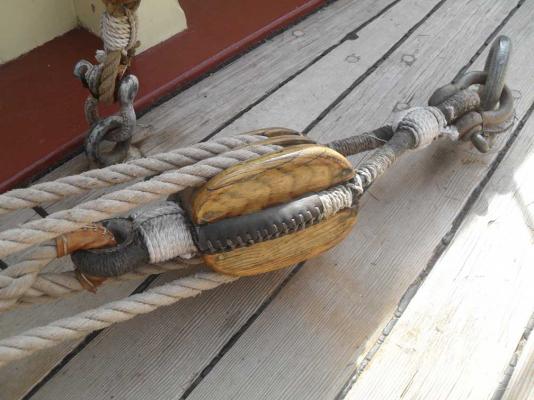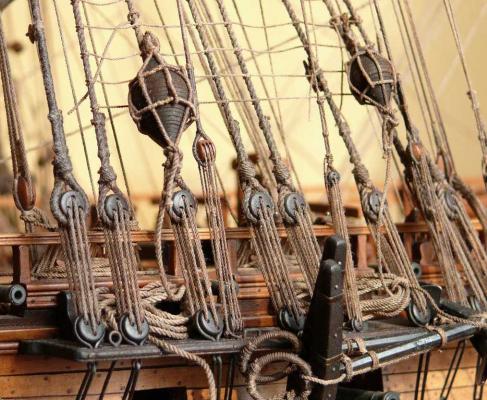
JerseyCity Frankie
Members-
Posts
1,338 -
Joined
-
Last visited
Content Type
Profiles
Forums
Gallery
Events
Everything posted by JerseyCity Frankie
-
Keeping the Yardarm Tackle rigged all the time never made any sense to me. Allowing the fall of the tackles to hang in loops REALLY makes no sense to me. Crew on the yard would always have to negotiate the line, particularly if it was left loose and could blow around their feet as they clung to the yard, or blew in their face as they went over the futtocks. On the other hand, if it was kept tight it would surely have a negative effect on bracing the yards. I'm sure when the time came to rig out a boat there would be enough hands available to rig the falls with the block aloft kept in place. But on the other hand, maybe they tried that and found it was dangerous not to have the boats instantly available?
-
I am devouring the Frigate version of this book, recently published. If the Ship of the Line book is anything like the Frigate book it will certainly be a Must Have. The Sailing Frigate A History in Ship Models by Robert Gardener 128 page hardcover with luscious high quality color photos covers the history of the development of this class of vessel from the 1600's through the 1850's. The author takes you through the design philosophy and political considerations that caused frigates to pass through different incarnations. Its a great source of information and worth the price for the wonderful photos alone. I am really looking forward to the Ship of the Line version of the book and hope it will not be long delayed.
-
If I had ANY of the series of these books I would not part with them. They are rather expensive and difficult to come by and these attributes are matched with spectacular comprehensive content that is beautiful. Its on my list of "if I ever win the lottery" things I would buy for myself if price was no object, in fact they would be near the top of the list.
-
As Henry says above, they are for larger stuff. If there is a haws hole indicated on your model near the location of a kevel built into the bullwarks, this is where a dockline would come inboard and be belayed to the kevel. So it may be you won't have any line on your models kevel unless you're intending her to be tied up on a pier.
-
Another useful line but one not always indicated on rigging plans is the Gantline. Its a medium sized line running almost like a flag halyard to a block near the masthead. Its only use is for lifting objects aloft, or a person in a boatswains chair. The Runner Pendants cant lift anything even into the tops, and there is a constant need for equipment on the masts. Anything the men can't carry themselves into the rig goes up on the gantline.
-
They strike me as odd ropes to have around too. If you need to have a purchase aloft, why not just put a line around the masthead over the Trestle Trees? I guess you would need twenty more feet of rope to do it that way, if you didn't have the tackles hanging there. And I suppose the fact that they are there on every ship speaks to the fact they must have tried getting along without them and came to the conclusion they were better to have than not.
-
ensign and signalling flags for the Bounty
JerseyCity Frankie replied to Ian B's topic in Masting, rigging and sails
This topic is covered pretty comprehensively in another thread here somewhere. In short, the flag is tied to a Flag Halyard that is run through a very small block or sheave at the very top of the mast. If its a sheave its set directly into the cap on the masthead. The flag halyard material is some of the thinnest line on the whole ship so on your model make it the thinnest stuff you have. its one long line that runs all the way up to the masthead then all the way back down to the deck, this way the flag can be set or struck by someone standing on the deck, you don't have to climb up there to get it. It will belay immediately aft of the aftermost line coming off the mast it is on. No other line coming off the mast in question will belay behind this line. Its the highest line on the mast so it will be the aftermost line on the pinrail. -
Kevels use the same friction principle as Belaying Pins and Cleats do. The end of the working line is taken to the Pin, the Cleat or the Kevel and three figure eight turns are taken around the two projections each of these things have. Its assumed the line is under strain or will be under strain. When the strain comes on the line, friction occurs where the line crosses over itself at the center of each figure eight turn. There is also friction where the line makes the 180 degree turns around the projections, but the main holding power comes from the line being made to press down on itself at the center of those figure eight turns.
-
In a remarkable coincidence I was just this very evening reading an account of the shelling of Hartlepool in Robert K Massie's excellent Castles of Steel. Reading it for the second time. Its even better than I remembered it. I think all MSW people interested in Steel Navy should certainly have it on their shelf.
- 33 replies
-
- warspite
- battleships
-
(and 1 more)
Tagged with:
-
Flying Fish Yards - moved by moderator
JerseyCity Frankie replied to Samgauthier's topic in Masting, rigging and sails
Hello Sam welcome to Model Ship World. I see this is your first post, congratulations. Flying Fish is a nice subject too. I did a quick web search and found this amazing treasure trove of information: http://www.bruzelius.info/Nautica/News/BDA/BDA(1851-11-04).html According to this source, the Fore is 70', the Main is 80' and the Mizzen is 59' long. You have not mentioned the scale of the version you are building but if you know the scale, you should be able to do some simple math and come up with the measurement in inches the model yards should be. -
Lettie stopped in Jersey City for fuel a month or so ago and I got a few snaps. Here is a shot showing the boltrope. I blew up the detail and inserted it in the oval inset.
-
Another factor in favor of the boltrope is that including the boltrope makes making the tack sheet and head cringles or rings that much easier as you simply form tiny loops in the boltrope at the three corners of the sail. Lettie has metal thimbles on her sails.
-
Signal Flags - Ships Name
JerseyCity Frankie replied to _SalD_'s topic in Masting, rigging and sails
I photograph the flags in maritime paintings whenever I come across them. I have been adding to this collage now and then. These shots are nearly all of commercial ocean carrier type cargo ships of the late 1800's. Note that in many cases the hoist starts with a number and there are nearly always four letter flags beneath. Not sure if this helps but I am throwing it in there. -
I'm a huge knot nerd and I am glad to see a conversation here about knots. Naturally, sailors are the best at tying knots and ship model builders can only benefit by learning some of the knots of the sailor. Model builders though probably only need to know a very few knots in order to aid in rigging their ships. The Overhand Knot and the Clove Hitch being the two absolute essentials. I am a big promoter of the Constrictor Knot too as I think it easily has a place among the "top ten" most useful knots. If I was to make a short list of "least know but most useful knots" the Constrictor would be my only submission. Sailors will argue endlessly about which are the ten knots everyone on a ship should know. They all agree the Bowline, Clove Hitch, Reef Knot, Sheet Bend and Rolling Hitch should be on the list but will begin to argue about what the other five should be. There are so many choices. Personally I would leave the Sheet Bend off the list but I know this is a heretical opinion. I just never have any confidence in it as I have too often seen it misbehave in different types of line.
-
Stropping and Seizing
JerseyCity Frankie replied to Stuntflyer's topic in Masting, rigging and sails
Here is a photo I took on the Pride of Baltimore II showing a rope stropped block with a becket. This block has a becket on the bottom, the part with the shackle through it holding it to the ringbolt in the deck. On your model the becket is larger than the one shown and is the part that is fitted around the boom. The rope grommet which IS the Strop was made large enough to fit around the block AND have enough material left over to form the two seized eyes on either side of the block. In this case the strop was served and leathered to keep it from chafing. The seizings which formed the eyes were done with a lighter colored line and show up well in the photo. Metal thimbles are set into the seized eyes but this is not always done. On your model you will have to make up some sort of loop of line appropriately thick enough for your strop, and long enough to go around the block, the spar on one side of the block and the small eye on the other. Making the seizings to form the eyes should present no trouble. -
...And don't forget the gold doubloon nailed into the after side of the Main Mast! Chains for the lightning rod in the chains of the ship, which Ahab ignores. Tiny details but Ahab had two holes bored in the deck in order to hold his ivory leg. Queequeg's coffin turned into the life Buoy. The French engraver Baugean always showed a life ring dangling aft of the tafrail hanging under the boom. Hanging a tiny coffin off the model would be very cool.
-
I'm reading Moby-Dick again right now. Best novel ever? maybe. I jotted some notes while reading it, on page 321 of my addition in the chapter The Grand Armada the line ..."With stun-sail piled on stun-sail we sailed along...." so Pequod has Stunsails. A couple times in the novel they mention the Sperm Whale jaw used as a tiller. When Melville introduces the carpenter (chapter 107) he tells us the carpenters bench lives "Athwartships against the rear of the tryworks". In the same chapter its noted that Stubb's whaleboat oars have red stars painted on the blades. I am tempted to build a pequod, I am every time I read the novel, but I am also tempted to build the barque Sunbeam, which Clifford Ashley painted so many times. Ashley wrote The Yankee Whaler and sailed on a whaling voyage. He also wrote The Ashley Book of Knots, which he is best known for. But in his paintings he shows a lot of detail of the Sunbeam, giving us more to go on for a model than Melville did.
-
I can never resist putting in my two cents on the issue of weather or not to include sails on a sailing ship model. I always try to advocate for including the sails since I view them as a defining aspect of a sailing vessel. The argument against sails is most often framed from the perspective that "they block the view of details on the model" and that they "are difficult". I will certainly agree that they are difficult! But I don't think that is an excuse to leave them off the model. The idea that they block the view of other aspects of the ship is true only in the sense that actual sails block the view of actual aspects of an actual ship. Thats how actual ships appear. Incidentally there are other things that are difficult to manage on ship models which ALSO block the view of deck details and are time consuming and difficult to make and install: Cannons! But you NEVER see people omit the cannons.
-
Flag hailyard line is going to be the thinnest rigging on the whole ship. I don't know the scale of the model you are building but its likely you don't need any special blocks secured aloft for the flag hailyards on your model, the real ones would be smaller than the palm of your hand. Your plan seams to indicate a ring at the masthead, if this is intended for the flag hailyard I would omit it. The ball at the top of the mast is called the Truck. Often the truck on an actual ship has the sheaves for two flag hailyards cut into it. Otherwise the Truck is merely ornamental. Its likely that if you have a kit supplied truck that it will be too big and out of scale, find something at home that is the right size- the Truck should not be more than a few scale inches wider than the masthead itself. If it was me, I would run a single line of the smallest thread I could find directly to the Truck. Rigging generally belays on deck in such a way that the higher up in the rigging the line originates, the farther aft it belays on the rails at the bulwarks. So your flag hailyard at the masthead is the highest bit of rigging on the mast and should be belayed farthest aft of all the rigging for that mast on the rail.
-
I found this shot on my computer, don't know what ship or model it is off of. This is not the first time I have seen the horizontal scored appearance of the buoy itself which suggests to me they are solid constructed bread and butter fashion? That would make them rather heavy, is it possible they are cork? Until this thread started me thinking about it I had always assumed the buoys were made like barrels, hollow, but that would not explain the horizontal scores.
-
I like everything about this project! Very ambitious to scratchbuild this monster. 1/48 scale plans must have been eight feet long? There is a really nice model of the Pennsylvania in the Brooklyn Navy Yard Museum if you ever visit New York. I love the odd history of the ship too, such a beheamoth and actually under sail just a handful of times! She must have been quite a sight!
-
Harland has a nice description with illustrations on page 241 of Seamanship in the Age of Sail. In use the buoy marks the location of the anchor on the sea floor and the line attaching it to the anchor is strong enough to weigh the anchor in unusual circumstances such as if the ship had to cut and run. Marking the anchors location also helps prevent fouling the anchor while raising it since the visual cue allows for anticipating problems with fouling other vessels or who knows what else in the area. Which makes me wonder if attempts were ever made to paint the buoy in high visibility colors or stripes or checkers. A buoy like this is really just a large wooden barrel and I suppose it and its lines would have otherwise been heavily tarred to insure longevity since it spent its life either directly in the sea or in its exposed position in the fore shrouds.
About us
Modelshipworld - Advancing Ship Modeling through Research
SSL Secured
Your security is important for us so this Website is SSL-Secured
NRG Mailing Address
Nautical Research Guild
237 South Lincoln Street
Westmont IL, 60559-1917
Model Ship World ® and the MSW logo are Registered Trademarks, and belong to the Nautical Research Guild (United States Patent and Trademark Office: No. 6,929,264 & No. 6,929,274, registered Dec. 20, 2022)
Helpful Links
About the NRG
If you enjoy building ship models that are historically accurate as well as beautiful, then The Nautical Research Guild (NRG) is just right for you.
The Guild is a non-profit educational organization whose mission is to “Advance Ship Modeling Through Research”. We provide support to our members in their efforts to raise the quality of their model ships.
The Nautical Research Guild has published our world-renowned quarterly magazine, The Nautical Research Journal, since 1955. The pages of the Journal are full of articles by accomplished ship modelers who show you how they create those exquisite details on their models, and by maritime historians who show you the correct details to build. The Journal is available in both print and digital editions. Go to the NRG web site (www.thenrg.org) to download a complimentary digital copy of the Journal. The NRG also publishes plan sets, books and compilations of back issues of the Journal and the former Ships in Scale and Model Ship Builder magazines.





